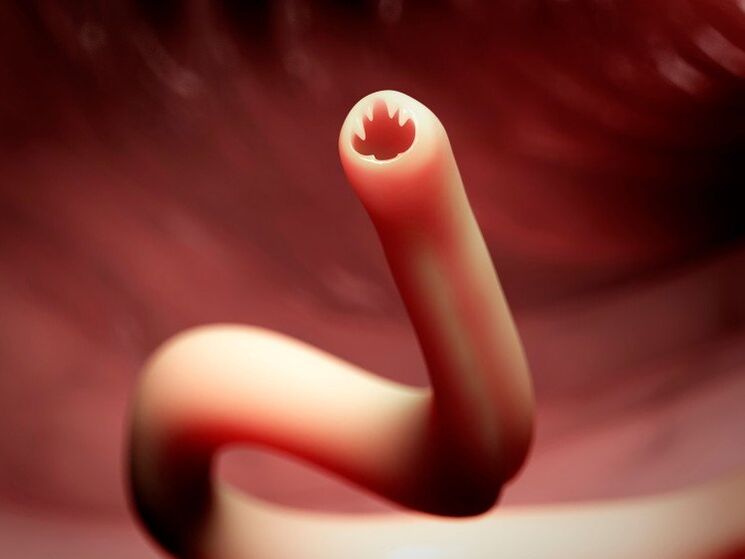
Worms or worms are a kind of disease that conceals its course well. Therefore, a person often cannot cure the phenomenon that deteriorates his health. Knowing the main signs of worms, you can accurately determine their presence in the body.
The main thing to remember is to correctly assess the specificity of the patient's condition and course of disease. For effective and timely treatment, it is necessary to conduct detailed research on the performance of worms.
How can you get a worm
Any adult can become a carrier of the parasite, and children are also susceptible to infection.
Worms can enter the human body in many ways, namely:
- water;
- food;
- Contact and family;
- Self-infection
- Can spread.
The first waterway infection is based on the intake of water, which contains worm eggs or larvae. The larva enters the water through an intermediate host (such as a mollusk), then leaves its body and develops independently, attaching to aquatic plants. Once the liquid enters the organism, the worm enters the digestive system and settles here.
This process often occurs in rivers, ponds, lakes, and springs. To avoid pollution, you need to stop drinking open source water, especially children. If the case forces people to absorb the water, boiling or filtering through a special filter is a prerequisite.
The way of food entry is the main and most common principle of infection. It is directly related to non-observance of basic hygiene or violation of the technique of cooking dishes with meat and fish. Worms penetrate through dirty hands, vegetables, berries, fruits, etc. Anything that grows on the ground may contain worm eggs. They emerge from the feces of ascariasis patients and live under favorable conditions for them for a long period of time. The most likely infection is the feces containing roundworm eggs in the soil.

The larvae found in meat and fish enter the body along with undercooked food. Once in the human body, these worms will eventually develop into individuals capable of laying eggs on their own. It is worth mentioning that a worm can produce hundreds of thousands of new eggs in 24 hours.
In order not to be infected or experience the signs of worms, it is necessary to buy meat and fish only at the place of inspection, pay attention to the presence of veterinary control, and check the meat, especially the liver, for the presence of worms. Food must be thoroughly cooked (steamed and fried), kitchen utensils must be properly handled, and the room protected from flies. The claws of flies can carry worm eggs.
The home contact method involves infiltrating worms through contact with household items and animals that carry worm larvae. Statistics show that more than 70% of the population on the planet is infected with worms, and half of them are infected through contact with pets. This is dangerous because signs of the presence of worms in animals may not show up at all. But in humans, the symptoms of worm invasion are nausea, constipation, vomiting, intestinal pain, and weight loss.
Regarding self-infection, children are often susceptible, especially kindergarten-age and younger school children. Children do not always follow the rules of hygiene, for example after going to the toilet. Invasion of infantile worms is the development of enterobiasis. The eggs of pinworms are very light, so they will be blown by a gust of wind on toys, bedding, furniture, and can also carry dust into the body. When the worms in a child or adult enter puberty, they crawl onto the wall of the anus and begin to lay eggs. The itch begins, these are the main signs of worm penetration. At night, the child can scratch the anus, and then put the bug into the mouth with his hands, and the cycle repeats.
Regarding infectious infections, it should be said that they are caused by insect bites. These can be mosquitoes, mosquitoes, fleas on pets. In most cases, the infection occurs on the filaments (filariasis).

Symptoms of adult worms
The presence of worms in the body can be identified by special signs, but they may vary from person to person.
This characteristic of severely infected patients:
- Exhausted
- Weight loss (a sharp drop in weight);
- Pale skin;
- Severe itching in the anus.
Depending on the location and number of worms, certain symptoms may appear.
In the brain
The first and main symptom implies the presence of worms in the brain, which is a general deterioration of health. It is not permanent, but temporary and periodic. A necessary measure is to take a picture on an ultrasound machine, and then the worm in the brain looks like a tumor.In addition, symptoms should include:

- lethargy;
- Shocked;
- Nausea and vomiting;
- This disease can cause seizures such as epilepsy;
- The temperature rises for no apparent reason.
These symptoms are common; special research will help to see the common situation more clearly.
In the body
Among all parasites on the earth, there are more than 250 kinds of worms that can harm the human body. They can exist almost in the entire body: heart, muscle, liver, subcutaneous, etc.
The symptoms of each case will be different, but there are still some common signs.
- Weak immune system;
- Joint and muscle pain;
- nervous;
- Fatigue has become chronic;
- Underweight
- Deterioration of the skin.
In the intestines
In most cases, worms settle in the intestine, and in such an environment it is easier to penetrate here and reproduce. You can learn about the existence of "residents" in the following ways:
- Constant and repeated abdominal distension;
- diarrhea;
- Weight fluctuations;
- Flatulence;
- Feeling of constant hunger.
Signs of worms and how to use tests and other diagnostic methods to identify worms
When a person is infected with a worm, there may be no symptoms in the initial stage. Only when the worms start to multiply can you see signs of worms in your home. When the body is poisoned by toxins, the first sign starts, the parasites will absorb the nutrients that people get from food.

The manifestation of worms may be due to the following symptoms:
- diarrhea;
- Abdominal discomfort;
- Flatulence;
- Bloating;
- Bile stagnation;
- constipate;
- Allergic manifestations;
- Intestinal inflammation;
- Joint and muscle pain;
- Dermatitis, eczema;
- Brittle nails, skin cracks, skin discoloration;
- anemia;
- lose weight;
- Nervous system disorders, anxiety symptoms, sleep disorders;
- Grind your teeth while sleeping;
- Excessive fatigue and decreased performance;
- Respiratory system problems: inflammation, pneumonia, asthma;
- Weakened immune system;
- Oncology (if helminthiasis has not been treated for a long time).
Ways to determine the worm
Doctors must know how to determine the worm in a person's body. For this reason, an examination is usually performed, which will help to confirm or refute the existence of the worm. After the completion of the main phase (collection of medical records), a diagnostic procedure is prescribed. Which research will be conducted depends on the severity of the symptoms and the type of helminthiasis. But it must be tested to avoid infection with worms.
Blood parasite detection
This analysis is prescribed to detect the presence of worms. For its delivery, preparation is required, and such conditions will allow more accurate diagnosis. In addition, both adults and children should follow these recommendations.
- Do it on an empty stomach in the morning;
- At least 9 hours have passed since the last meal;
- You can drink water, excluding the carbonated version;
- You need to stick to your diet for 3 days, and there should be no salty, spicy, or smoky food;
- Minimize physical activity and stress;
- Stop using the drug for any purpose within 14 days.
It happened that the analysis did not show accurate results, and there were signs of worms. In this case, you need to donate blood and feces again, maybe the result will be positive next time.

Worms in the stool
The presence of worms can be determined by the most common method-the transportation of feces. Distinguish the quadrant method and the Kato method. The first involves visual inspection and chemical research of feces. The Kato method visually reveals whether there are worms, and the biological material, namely feces, is placed on a special glass.
Other signs of worms in children
To determine whether your child has an infection, you need to pay attention to his appearance. Almost every parent knows how to determine a child's worm at home. For signs of a worm's obvious appearance, the following symptoms will indicate:
- Dark circles under the eyes;
- Facial skin is pale;
- The body does not eat, and the appetite is not good;
- Excessive salivation;
- Vomiting, nausea;
- Instability of the intestines and constipation, diarrhea, stomach pain;
- Dizziness;
- weakness;
- Increased tears, moodiness;
- Itching in the anus, worms can even crawl out, visible to the naked eye;
- Redness between the hips.
Worm invasion: symptoms of parasite types and ways to fight them

Human infection with worms can occur in many ways. It is usually due to poor hygiene or contact with worm carriers. Parasitic diseases are considered dangerous because they cleverly disguise themselves as other diseases. Therefore, the symptoms may indicate a disease, worm invasion, and ambiguity.
To find out the cause, multiple diagnoses are required. As for treatment, it is strictly individualized, and there is a comprehensive approach, because it is important not only to recognize the existence of worms, but also to get rid of the consequences caused by them staying in the body.
When worms enter the body, they consume all the important ingredients needed for normal function. Nonetheless, they can release toxic substances, have a negative impact on the immune system, and damage tissues and organs. If the disease is not treated in time, this can lead to terrible consequences, up to the tumor or even death.
Signs by worm type
Depending on the situation, worm invasion has the characteristics of a certain worm, because there are hundreds of worms in nature. Pinworms are considered the most common because infections can occur throughout the year. Each type of worm, whether round or band-shaped, is manifested by decreased immune system function, visceral damage, poisoning, allergies, and so on.
round
Roundworms or nematodes are a dangerous worm invasion, the symptoms of which may not appear immediately in some cases. In order to stay in the human body comfortably, worms need oxygen, a suitable temperature and a certain amount of humidity. All this is in the human body.
The symptoms of this type of worm are very similar to those of a cold:
- The pain of wandering;
- Slight nausea;
- Violation of appetite;
- Exhausted;
- Stool disorders;
- Inflammation of the stomach wall and the resulting pain;
- Acute allergies;
- Poisoning;
- If you miss the treatment, it will violate the working rhythm of all human organs.
The types of roundworms are quite wide, so the physical signs are also different. For example, with the development of enterobiasis, itching may occur in the anus, especially at night. For ascariasis, the larvae actively migrate with the blood, so they can appear anywhere. Trichinosis develops with severe fever, muscle pain, facial swelling, and bright red rash.

Tape
Tapeworms are also subdivided into many types, including broad tapeworms, bovine tapeworms, and hydatid tapeworms. Home remedies for these types of parasites are ineffective. Worm invasion and its symptoms are obvious in certain situations.
So, with the development of a wide range of tapeworms in the body, it can be:
- Pancreatic pressure;
- Decreased stomach acidity;
- The digestion process is disturbed;
- Blockage of the intestines;
- lose weight;
- anemia;
- In severe cases, the course of the disease can aggravate internal organs, high fever, and numbness of the limbs.
With the development of tapeworms, similar symptoms are observed, headaches are frequent, and appetite increases or decreases sharply.
In the case of echinococcosis, the lungs and liver are damaged, and the muscles, brain, and bones are less likely to be damaged. With liver damage, pain is observed in right side hypochondriac, heartburn, jaundice, and liver cirrhosis. If the disease develops in the lungs, a severe dry cough with blood impurities and shortness of breath will begin. In the abdominal cavity, the growth of this worm is particularly dangerous because it can cause severe poisoning, allergies, peritonitis, and anaphylactic shock.
Human anthelmintics
Deworming methods can be divided into drugs with a narrow range of action and drugs with a wider range of action. The first type is based on the use of protivocestodozny drugs, and the second-deworming drugs. The latter are the most commonly used prescriptions. They are effective against parasites, prevent their growth and reproduction, and quickly remove them from the body.
Use narrow spectrum depending on the situation and neglect. Self-medication may endanger health and life! Visiting experts is a must.










